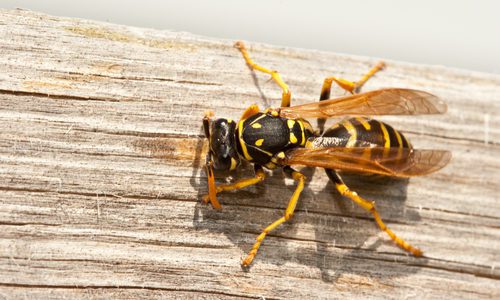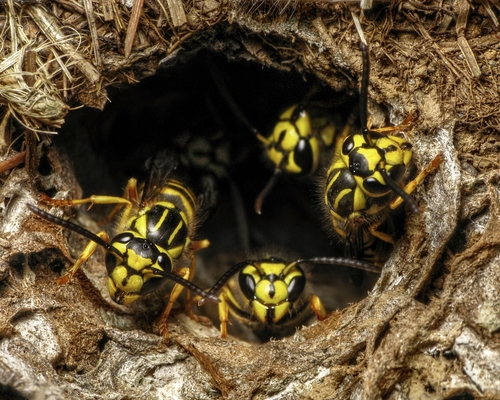
What is a Yellowjacket?
Yellowjackets (or yellow jackets) are stinging pests that get their name from the distinctive yellow and black coloring they possess. Occasionally, you may see varieties that have some white markings among the yellow and black, but this patterning is much less common. They are a type of wasp and in comparison to other small, black and yellow stinging insects like bees, yellow jackets have a distinctive slim waist and elongated, folding wings.
They’re pollinators that eat a wide variety of foods including grubs, flies, other pests, meat, fish, and sugary substances they might scavenge. Another distinctive feature of yellow-jackets is the fact that they are ground-nesters so their colonies are most commonly found beneath your feet as opposed to above your head. Their reproductive cycles include a queen building a nest and continuing to populate it over time. A single colony can amass over 1,000 workers in a single season, so it’s safe to say that if you find one in or around your home or business that you should call professionals immediately.
Are Yellowjackets aggressive?
Yellowjackets are the most aggressive of all the stinging insects and quick to defend themselves when they feel threatened. They are capable of both stinging and biting and often combine both to latch on and give multiple painful stings.
Are yellow jackets dangerous?
Since yellow jacket nests can have hundreds of inhabitants and they defend their nests very staunchly, they are considered dangerous. If you see one of their nests near your home you should immediately call professionals instead of going near it on your own.
Why do I have Yellowjackets?
If you notice worker yellowjackets buzzing around any part of your home, they probably have a nest nearby. Call professionals immediately and be careful doing work in your yard until they’ve come to assess the situation. You don’t want to accidentally upset a nest they’ve built.
The main reason yellow jackets are drawn to your home or business is food. Access to readily available sweetness like fruit trees or improperly cleaned recycling or garbage bins will draw yellow jackets, hornets and wasps.
How to Get Rid of Yellowjackets
The best way to get rid of yellow jackets is to avoid them all together. How to prevent yellow jackets:
- Keep a tight seal on any outdoor trash cans and regularly clean them to prevent yellowjackets from hunting for food within.
- Don’t leave pet food outside.
- Remove any fallen fruit from trees so they’re not drawn to the sweet refuge.
- Clear rodents from your yard and close any tunnels and burrows. Since many yellowjackets and wasps repurpose existing underground structures, this will help prevent yellow jacket ground nests from forming around your home or business.
Yellow jacket removal: How Gregory Pest can help
When yellow jacket prevention fails, call in the specialists. An expert from Gregory Pest Solutions who specializes in removing yellow jackets is your best bet. We can safely eliminate them and remove their nests from your home or business.
When you hire us to evaluate your home’s pest problem, one of our pros will be sent to assess the yellowjacket situation and then formulate an environmentally friendly plan for removal and prevention. You get fast, reliable yellowjacket extermination and long term solutions to your pest problem.
Yellowjacket FAQ
How Do I get rid of a yellow jacket nest?
Your best bet is to wait until dark. Because of their vision, wasps and bees can’t fly in the dark very accurately. Spray the nest with a wasp insecticide and cross your fingers. If you want to be sure the job is done properly without being stung, call a yellow jacket pest control professional like Gregory.
What does a yellowjacket nest look like?
Most yellow jacket nests are underground. The nest entrance will look similar to a gopher hole or other rodent burrow with dirt and pebbles piled around the entrance. Common locations to find include under porches, near tree trunks and beneath sidewalks. Eastern yellowjackets may nest in a tree hollow.
Are there different types of yellowjackets?
There are four types of yellowjacket native to North America: The North American yellowjacket, eastern yellowjacket, western yellowjacket and prairie yellowjacket. They can be distinguished by subtle differences in their color pattern.
Are yellow jackets wasps?
Yes, all yellowjackets are wasps but not all wasps are yellowjackets.
Do yellow jackets pollinate?
Yes, but not on the same level as bees. Because their smooth bodies lack the soft hairs that bees have, yellowjackets cannot pick up or transport as much pollen.
Where can I get help with Yellowjackets?
Gregory Pest Solutions has your back when it comes to pest prevention. Call us for help removing current infestations, preventing future ones, or implementing exclusion plans. We offer residential and commercial pest control services to all states listed below.
If you live in the east-central or southeastern United States, Gregory Pest Solutions and our pest control solutions are only a call away.

